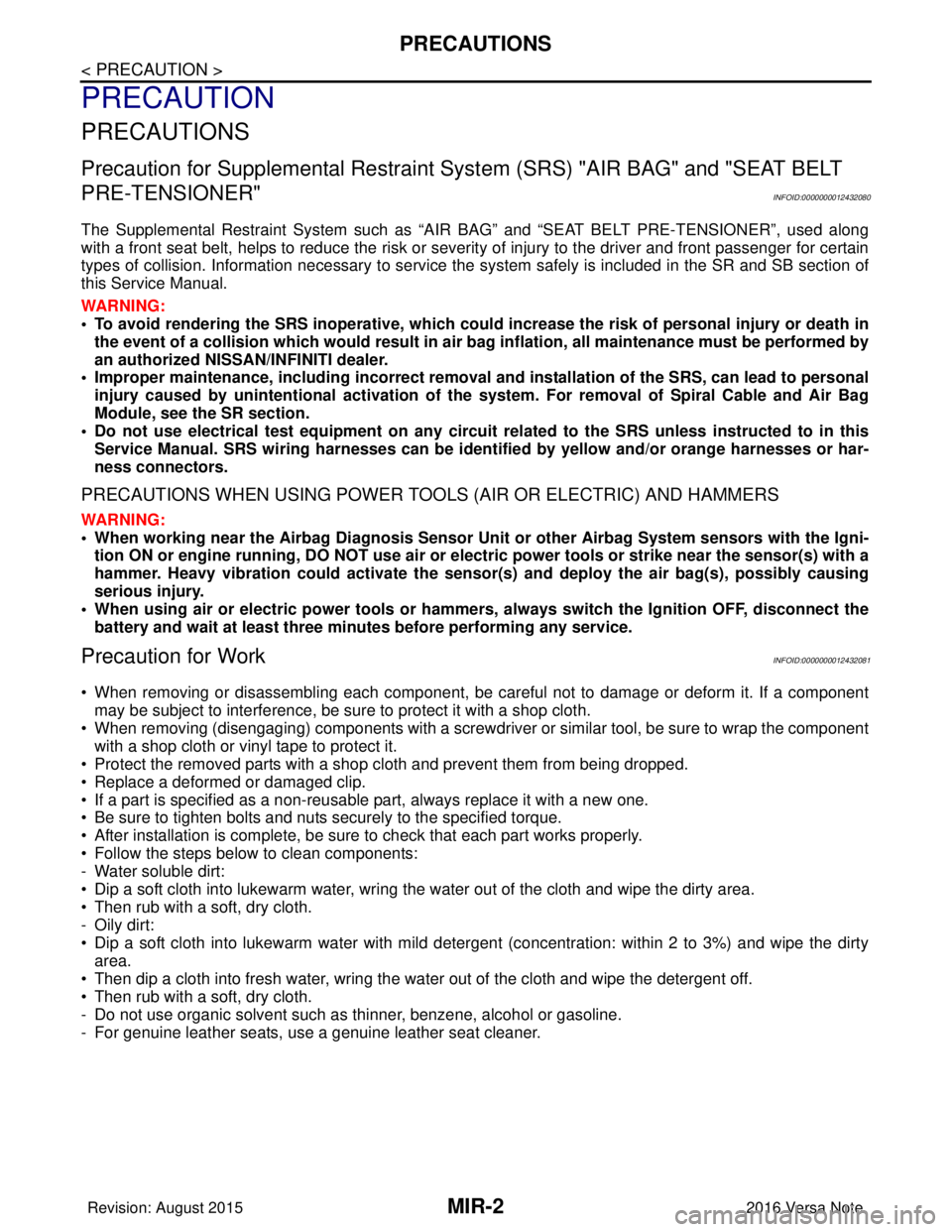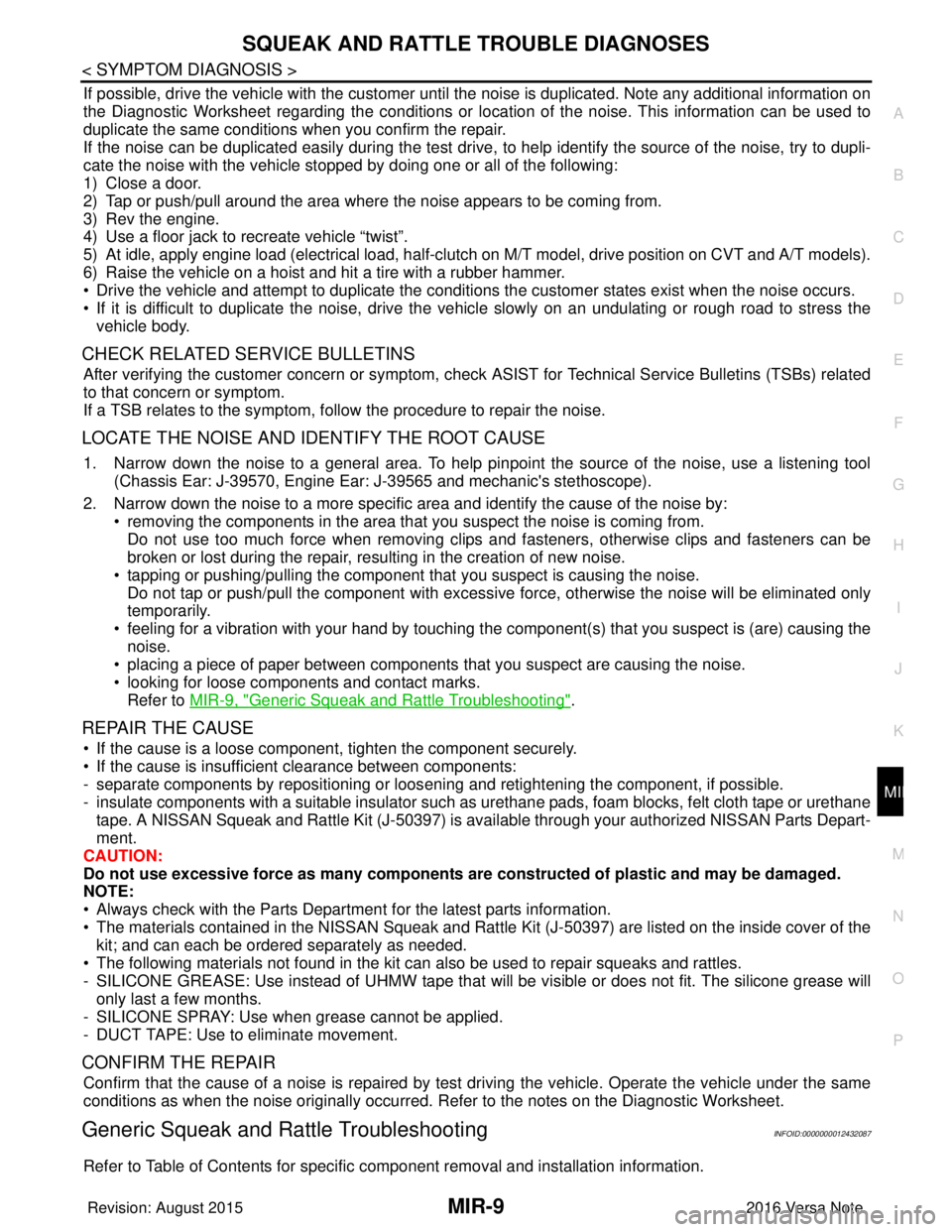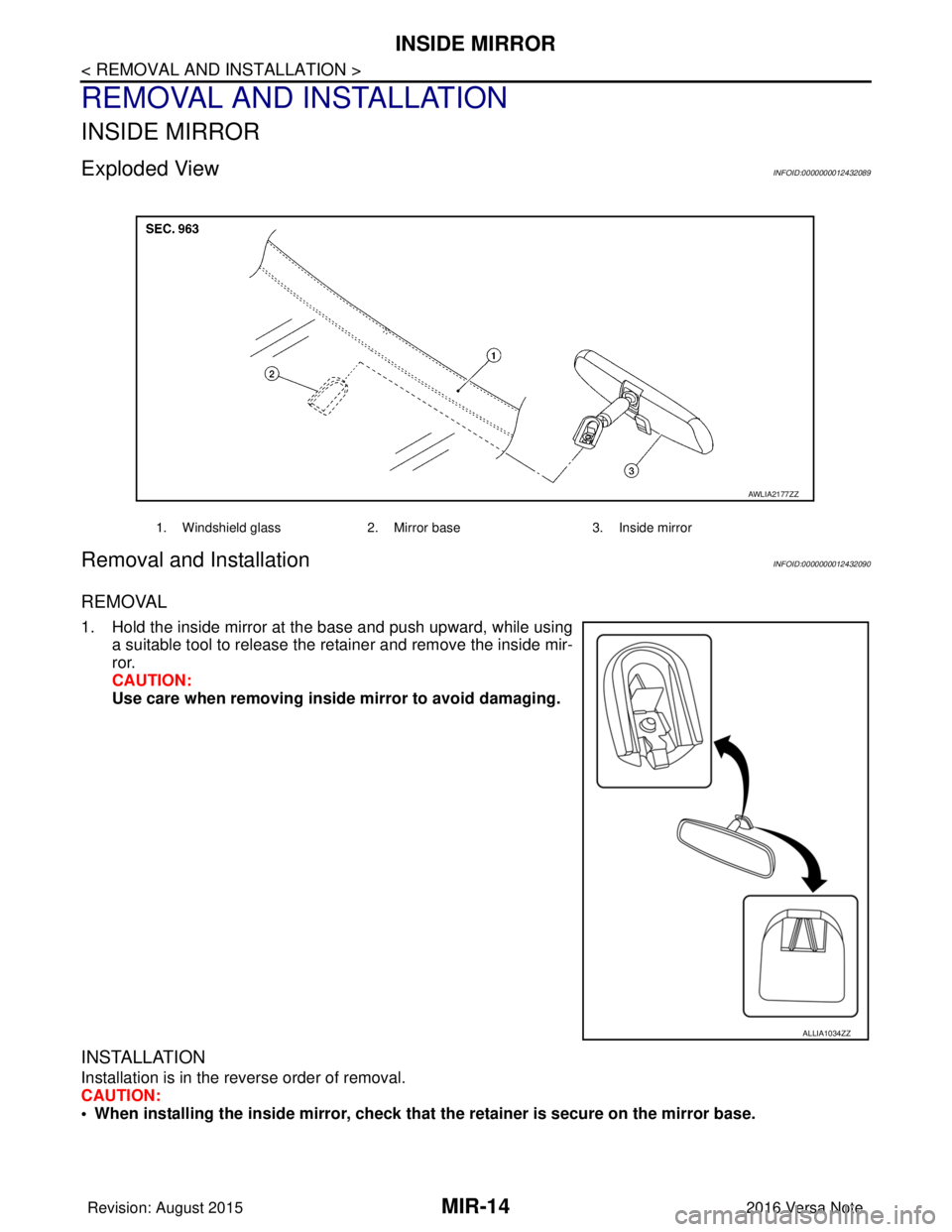2016 NISSAN NOTE ECU
[x] Cancel search: ECUPage 2433 of 3641
![NISSAN NOTE 2016 Service Repair Manual MWI
COMBINATION METERMWI-75
< ECU DIAGNOSIS INFORMATION > [TYPE B]
C
D
E
F
G H
I
J
K L
M B A
O P
*: Displays “Off” if the brake warning lamp is illumi nated when the valve check starts, the parkin NISSAN NOTE 2016 Service Repair Manual MWI
COMBINATION METERMWI-75
< ECU DIAGNOSIS INFORMATION > [TYPE B]
C
D
E
F
G H
I
J
K L
M B A
O P
*: Displays “Off” if the brake warning lamp is illumi nated when the valve check starts, the parkin](/manual-img/5/57363/w960_57363-2432.png)
MWI
COMBINATION METERMWI-75
< ECU DIAGNOSIS INFORMATION > [TYPE B]
C
D
E
F
G H
I
J
K L
M B A
O P
*: Displays “Off” if the brake warning lamp is illumi nated when the valve check starts, the parking brake switch
is turned ON or the brake fluid level switch is turned ON.
CRUISE IND Cruise indicator
lampWhen cruise indicator lamp is ON.
ON
When cruise indicator lamp is OFF. Off
O/D OFF IND O/D OFF indi-
cator When O/D OFF indicator lamp is OFF.
Off
When O/D OFF indicator lamp is ON. On
FUEL W/L Low fuel warn-
ingWhen low fuel warning is ON
On
When low fuel warning is Off Off
AIR PRES W/L Tire pressure
warning lamp
operationWhen tire pressure warning lamp is ON
ON
When tire pressure warning lamp is OFF Off
EPS W/L EPS warning
lamp EPS warning lamp ON
On
EPS warning lamp OFF Off
KEY G/Y W/L Key warning
lamp When key warning lamp is ON
On
When key warning lamp is OFF Off
CHG SIG Charge warn-
ing lampEngine running
Off
PASS BUCKLE SW Seat belt buck-
le switch RHWhen seat belt buckle RH is unfastened
On
When seat belt buckle RH is fastened Off
FUEL CAP W/L Loose fuel cap
warningLoose fuel filler cap warning is ON
On
Loose fuel filler cap warning is OFF Off
PKB SW Parking brake
switchWhen parking brake is active
On
When parking brake is inactive Off
BUCKLE SW Seat belt buck-
le switch LHWhen seat belt buckle is unfastened LH.
On
When seat belt buckle is fastened LH. Off
BRAKE OIL SW Brake fluid level
switchWhen brake fluid level switch ON
On
When brake fluid level switch OFF Off
OUTSIDE TEMP
[ ° F] or [ °C] Outside tem-
perature
Ignition ON Displays the ambient air temperature
which is input from the ambient sensor.
DISTANCE Distance to
empty
While driving
[mph or km/h]
FUEL LOW SIG Low fuel warn-
ingWhen low fuel warning is On
On
When low fuel warning is Off Off
BUZZER Buzzer opera-
tionWhen Buzzer is ON
On
When Buzzer is OFF Off
TPMS PRESS L Low tire pres-
sure warningWhen check tire pressure warning mes-
sage is On
On
When check tire pressure warning mes-
sage is OFF Off
Monitor Item Display content
Data monitor
Condition Reference value in normal operation
Revision: August 2015 2016 Versa Note
cardiagn.com
Page 2434 of 3641
![NISSAN NOTE 2016 Service Repair Manual MWI-76
< ECU DIAGNOSIS INFORMATION >[TYPE B]
COMBINATION METER
TERMINAL LAYOUT
PHYSICAL VALUES
JSNIA5390ZZ
Te r m i n a l
No. Wire
color Item Condition
Reference value (V)
(Approx.)
Ignition
switch NISSAN NOTE 2016 Service Repair Manual MWI-76
< ECU DIAGNOSIS INFORMATION >[TYPE B]
COMBINATION METER
TERMINAL LAYOUT
PHYSICAL VALUES
JSNIA5390ZZ
Te r m i n a l
No. Wire
color Item Condition
Reference value (V)
(Approx.)
Ignition
switch](/manual-img/5/57363/w960_57363-2433.png)
MWI-76
< ECU DIAGNOSIS INFORMATION >[TYPE B]
COMBINATION METER
TERMINAL LAYOUT
PHYSICAL VALUES
JSNIA5390ZZ
Te r m i n a l
No. Wire
color Item Condition
Reference value (V)
(Approx.)
Ignition
switch Operation or condition
1 L CAN high —— —
2 P CAN low —— —
4LG8P/R — — —
6 W Fuel level sensor signal (+) — —Refer to
MWI-102, "
Component Inspec-
tion".
7VAir bag — — —
8 P O/D OFF switch ONO/D OFF switch pressed
0
O/D OFF switch released Battery voltage
9 V Seat belt buckle switch LH ON Unfastened (ON)
0
Fastened (OFF) Battery voltage
10 SB Parking Brake switch ONParking brake is inactive
Battery voltage
Parking brake is active 0
11 BR Brake fluid level switch ON Brake fluid level low
0
Brake fluid level normal Battery voltage
15 R Ignition switch ON or ACC — —Battery voltage
16 B Illumination control switch (-) — ——
17
*1V Washer fluid level switch ON Washer fluid level low 0
Washer fluid level normal
Battery voltage
18 GR Security —— —
19 V Ambient sensor signal (+) ON ——
20 R Ambient sensor ground (-) — —0
21 B Ground —— 0
22 B
23 B
24 GR Fuel level sensor ground (-) ON —0
27 R/W Battery power supply OFF— Battery voltage
28 GR Ignition switch ON or START ON —Battery voltage
29 G Seat belt buckle switch RH ON Unfastened (ON)
0
Fastened (OFF) Battery voltage
36 LG Steering switch
(meter control switch)
——
—
38 Y Generator ONGenerator voltage low
0
Generator voltage no rmalBattery voltage
Revision: August 2015 2016 Versa Note
cardiagn.com
Page 2435 of 3641
![NISSAN NOTE 2016 Service Repair Manual MWI
COMBINATION METERMWI-77
< ECU DIAGNOSIS INFORMATION > [TYPE B]
C
D
E
F
G H
I
J
K L
M B A
O P
*1:For Canada
Fail-safeINFOID:0000000012432614
The combination meter activates the fail-safe contro l i NISSAN NOTE 2016 Service Repair Manual MWI
COMBINATION METERMWI-77
< ECU DIAGNOSIS INFORMATION > [TYPE B]
C
D
E
F
G H
I
J
K L
M B A
O P
*1:For Canada
Fail-safeINFOID:0000000012432614
The combination meter activates the fail-safe contro l i](/manual-img/5/57363/w960_57363-2434.png)
MWI
COMBINATION METERMWI-77
< ECU DIAGNOSIS INFORMATION > [TYPE B]
C
D
E
F
G H
I
J
K L
M B A
O P
*1:For Canada
Fail-safeINFOID:0000000012432614
The combination meter activates the fail-safe contro l if CAN communication with each unit is malfunctioning.
DTC IndexINFOID:0000000012432615
Function Specifications
Speedometer Reset to zero by suspending communication.
Tachometer
Illumination control When suspending communication, changes to nighttime mode.
Shift position indicator When suspending communication, not indicate.
Information display Trip com-
puterCurrent fuel consump-
tion
• When reception time of an abnormal signal is 2 seconds or
less, the last received datum is used for calculation to indi-
cate the result.
• When reception time of an abnormal signal is more than two seconds, the last result calculated during normal condition is
indicated.
Average fuel consump-
tion
Distance to empty
Odo/trip meter An indicated value is maintained at communications blackout.
Buzzer The buzzer turns OFF by suspending communication.
Warning lamp/indicator lamp ABS warning lamp
The lamp turns ON by suspending communication.
Slip indicator lamp
Malfunction indicator lamp (MIL)
VDC OFF indicator lamp
EPS warning lamp
Brake warning lamp
High beam indicator lamp
The lamp turns OFF by suspending communication.
Turn signal indicator lamp
Door warning lamp
Light indicator lamp
Engine oil pressure warning lamp
High water temperature warning
lamp
Key warning lamp
O/D OFF indicator lamp
Shift P warning lamp
Engine start operation indicator lamp
Display contents of CONSULT
Diagnostic item is detected when... Refer to
CAN COMM CIRCUIT
[U1000] When combination meter is not transmitting or receiving CAN communication signal for
2 seconds or more.
MWI-93
CONTROL UNIT (CAN)
[U1010]When detecting error during the initial diagnosis of the CAN controller of combination
meter.
MWI-94
VEHICLE SPEED
[B2205]The abnormal vehicle speed signal is input from the ABS actuator and electric unit (con-
trol unit) for 2 seconds or more.
MWI-95
ENGINE SPEED
[B2267]If ECM continuously transmits abnormal engine speed signals for 2 seconds or more.
MWI-96
WATER TEMP
[B2268]If ECM continuously transmits abnormal engine coolant temperature signals for 60 sec-
onds or more.
MWI-97
Revision: August 2015
2016 Versa Note
cardiagn.com
Page 2436 of 3641
![NISSAN NOTE 2016 Service Repair Manual MWI-78
< ECU DIAGNOSIS INFORMATION >[TYPE B]
BCM (BODY CONTROL MODULE)
BCM (BODY CONTROL MODULE)
List of ECU ReferenceINFOID:0000000012432616
ECU
Reference
BCM (with Intelligent Key system) BCS-30, "
NISSAN NOTE 2016 Service Repair Manual MWI-78
< ECU DIAGNOSIS INFORMATION >[TYPE B]
BCM (BODY CONTROL MODULE)
BCM (BODY CONTROL MODULE)
List of ECU ReferenceINFOID:0000000012432616
ECU
Reference
BCM (with Intelligent Key system) BCS-30, "](/manual-img/5/57363/w960_57363-2435.png)
MWI-78
< ECU DIAGNOSIS INFORMATION >[TYPE B]
BCM (BODY CONTROL MODULE)
BCM (BODY CONTROL MODULE)
List of ECU ReferenceINFOID:0000000012432616
ECU
Reference
BCM (with Intelligent Key system) BCS-30, "
Reference Value"
BCS-48, "Fail-safe"
BCS-49, "DTCInspectionPriorityChart"
BCS-50, "DTCIndex"
BCM (without Intelligent Key system)BCS-101, "
Reference Value"
BCS-115, "Fail-safe"
BCS-115, "DTCInspectionPriorityChart"
BCS-115, "DTCIndex"
Revision: August 2015
2016 Versa Note
cardiagn.com
Page 2476 of 3641

MIR-2
< PRECAUTION >
PRECAUTIONS
PRECAUTION
PRECAUTIONS
Precaution for Supplemental Restraint System (SRS) "AIR BAG" and "SEAT BELT
PRE-TENSIONER"
INFOID:0000000012432080
The Supplemental Restraint System such as “A IR BAG” and “SEAT BELT PRE-TENSIONER”, used along
with a front seat belt, helps to reduce the risk or severity of injury to the driver and front passenger for certain
types of collision. Information necessary to service the system safely is included in the SR and SB section of
this Service Manual.
WARNING:
• To avoid rendering the SRS inopera tive, which could increase the risk of personal injury or death in
the event of a collision which would result in air bag inflation, all maintenance must be performed by
an authorized NISSAN/INFINITI dealer.
• Improper maintenance, including in correct removal and installation of the SRS, can lead to personal
injury caused by unintent ional activation of the system. For re moval of Spiral Cable and Air Bag
Module, see the SR section.
• Do not use electrical test equipmen t on any circuit related to the SRS unless instructed to in this
Service Manual. SRS wiring harn esses can be identified by yellow and/or orange harnesses or har-
ness connectors.
PRECAUTIONS WHEN USING POWER TOOLS (AIR OR ELECTRIC) AND HAMMERS
WARNING:
• When working near the Airbag Diagnosis Sensor Unit or other Airbag System sensors with the Igni-
tion ON or engine running, DO NOT use air or electri c power tools or strike near the sensor(s) with a
hammer. Heavy vibration could activate the sensor( s) and deploy the air bag(s), possibly causing
serious injury.
• When using air or electric power tools or hammers , always switch the Ignition OFF, disconnect the
battery and wait at least three minutes before performing any service.
Precaution for WorkINFOID:0000000012432081
• When removing or disassembling each component, be careful not to damage or deform it. If a component may be subject to interference, be sure to protect it with a shop cloth.
• When removing (disengaging) components with a screwdriver or similar tool, be sure to wrap the component with a shop cloth or vinyl tape to protect it.
• Protect the removed parts with a shop cloth and prevent them from being dropped.
• Replace a deformed or damaged clip.
• If a part is specified as a non-reusable part, always replace it with a new one.
• Be sure to tighten bolts and nuts securely to the specified torque.
• After installation is complete, be sure to check that each part works properly.
• Follow the steps below to clean components:
- Water soluble dirt:
• Dip a soft cloth into lukewarm water, wring the water out of the cloth and wipe the dirty area.
• Then rub with a soft, dry cloth.
- Oily dirt:
• Dip a soft cloth into lukewarm water with mild detergent (concentration: within 2 to 3%) and wipe the dirty area.
• Then dip a cloth into fresh water, wring the water out of the cloth and wipe the detergent off.
• Then rub with a soft, dry cloth.
- Do not use organic solvent such as thinner, benzene, alcohol or gasoline.
- For genuine leather seats, use a genuine leather seat cleaner.
Revision: August 2015 2016 Versa Note
cardiagn.com
Page 2483 of 3641

SQUEAK AND RATTLE TROUBLE DIAGNOSESMIR-9
< SYMPTOM DIAGNOSIS >
C
DE
F
G H
I
J
K
M A
B
MIR
N
O P
If possible, drive the vehicle with the customer until the noise is duplicated. Note any additional information on
the Diagnostic Worksheet regarding the conditions or lo cation of the noise. This information can be used to
duplicate the same conditions when you confirm the repair.
If the noise can be duplicated easily during the test drive, to help identify the source of the noise, try to dupli-
cate the noise with the vehicle stopped by doing one or all of the following:
1) Close a door.
2) Tap or push/pull around the area where the noise appears to be coming from.
3) Rev the engine.
4) Use a floor jack to recreate vehicle “twist”.
5) At idle, apply engine load (electrical load, half-clutch on M/T model, drive position on CVT and A/T models).
6) Raise the vehicle on a hoist and hit a tire with a rubber hammer.
• Drive the vehicle and attempt to duplicate the conditions the customer states exist when the noise occurs.
• If it is difficult to duplicate the noise, drive the vehicle slowly on an undulating or rough road to stress the
vehicle body.
CHECK RELATED SERVICE BULLETINS
After verifying the customer concern or symptom, check ASIST for Technical Service Bulletins (TSBs) related
to that concern or symptom.
If a TSB relates to the symptom, follow the procedure to repair the noise.
LOCATE THE NOISE AND IDENTIFY THE ROOT CAUSE
1. Narrow down the noise to a general area. To help pinpoint the source of the noise, use a listening tool (Chassis Ear: J-39570, Engine Ear: J-39565 and mechanic's stethoscope).
2. Narrow down the noise to a more specific area and identify the cause of the noise by: • removing the components in the area that you suspect the noise is coming from.Do not use too much force when removing clips and fasteners, otherwise clips and fasteners can be
broken or lost during the repair, resulting in the creation of new noise.
• tapping or pushing/pulling the component that you suspect is causing the noise.
Do not tap or push/pull the component with excessive force, otherwise the noise will be eliminated only
temporarily.
• feeling for a vibration with your hand by touching the component(s) that you suspect is (are) causing the
noise.
• placing a piece of paper between components that you suspect are causing the noise.
• looking for loose components and contact marks. Refer to MIR-9, "
Generic Squeak and Rattle Troubleshooting".
REPAIR THE CAUSE
• If the cause is a loose component, tighten the component securely.
• If the cause is insufficient clearance between components:
- separate components by repositioning or loos ening and retightening the component, if possible.
- insulate components with a suitable insulator such as urethane pads, foam blocks, felt cloth tape or urethane tape. A NISSAN Squeak and Rattle Kit (J-50397) is available through your authorized NISSAN Parts Depart-
ment.
CAUTION:
Do not use excessive force as many components are constructed of plastic and may be damaged.
NOTE:
• Always check with the Parts Department for the latest parts information.
• The materials contained in the NISSAN Squeak and Rattle Kit (J-50397) are listed on the inside cover of the
kit; and can each be ordered separately as needed.
• The following materials not found in the kit can also be used to repair squeaks and rattles.
- SILICONE GREASE: Use instead of UHMW tape that will be visible or does not fit. The silicone grease will
only last a few months.
- SILICONE SPRAY: Use when grease cannot be applied.
- DUCT TAPE: Use to eliminate movement.
CONFIRM THE REPAIR
Confirm that the cause of a noise is repaired by test driving the vehicle. Operate the vehicle under the same
conditions as when the noise originally occurred. Refer to the notes on the Diagnostic Worksheet.
Generic Squeak and Rattle TroubleshootingINFOID:0000000012432087
Refer to Table of Contents for specific component removal and installation information.
Revision: August 2015 2016 Versa Note
cardiagn.com
Page 2485 of 3641

SQUEAK AND RATTLE TROUBLE DIAGNOSESMIR-11
< SYMPTOM DIAGNOSIS >
C
DE
F
G H
I
J
K
M A
B
MIR
N
O P
1. Loose harness or harness connectors.
2. Front console map/reading lamp lens loose.
3. Loose screws at console attachment points.
SEATS
When isolating seat noise it's important to note the position the seat is in and the load placed on the seat when
the noise is present. These conditions should be duplicated when verifying and isolating the cause of the
noise.
Cause of seat noise include:
1. Headrest rods and holder
2. A squeak between the seat pad cushion and frame
3. The rear seatback lock and bracket
These noises can be isolated by moving or pressing on the suspected components while duplicating the con-
ditions under which the noise occurs. Most of thes e incidents can be repaired by repositioning the component
or applying urethane tape to the contact area.
UNDERHOOD
Some interior noise may be caused by components under the hood or on the engine wall. The noise is then
transmitted into the passenger compartment.
Causes of transmitted underhood noise include:
1. Any component installed to the engine wall
2. Components that pass through the engine wall
3. Engine wall mounts and connectors
4. Loose radiator installation pins
5. Hood bumpers out of adjustment
6. Hood striker out of adjustment
These noises can be difficult to isolate since they cannot be reached from the interior of the vehicle. The best
method is to secure, move or insulate one component at a time and test drive the vehicle. Also, engine rpm or
load can be changed to isolate the noise. Repairs can usually be made by moving, adjusting, securing, or
insulating the component causing the noise.
Revision: August 2015 2016 Versa Note
cardiagn.com
Page 2488 of 3641

MIR-14
< REMOVAL AND INSTALLATION >
INSIDE MIRROR
REMOVAL AND INSTALLATION
INSIDE MIRROR
Exploded ViewINFOID:0000000012432089
Removal and InstallationINFOID:0000000012432090
REMOVAL
1. Hold the inside mirror at the base and push upward, while usinga suitable tool to release the retainer and remove the inside mir-
ror.
CAUTION:
Use care when removing inside mirror to avoid damaging.
INSTALLATION
Installation is in the reverse order of removal.
CAUTION:
• When installing the inside mi rror, check that the retainer is secure on the mirror base.
1. Windshield glass 2. Mirror base 3. Inside mirror
AWLIA2177ZZ
ALLIA1034ZZ
Revision: August 2015 2016 Versa Note
cardiagn.com